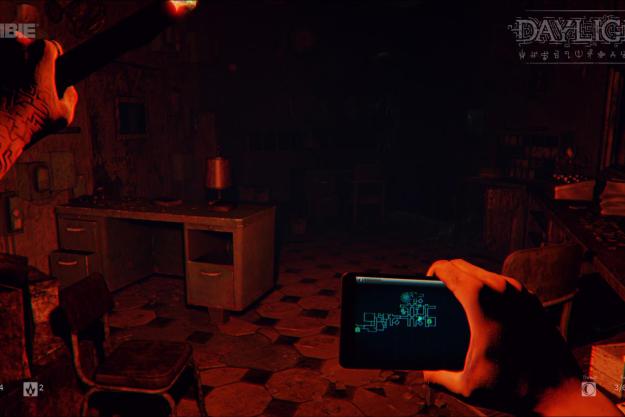
“Daylight’s inherent creepiness is undone by randomly generated elements that dispel the all-important illusion of survival horror.”
- Genuinely creepy atmosphere
- Outstanding sound design
- Random elements dispel the horror illusion
- Not enough variety in the environments
Survival horror works only when you buy into the illusion. The moment you know the ground rules – when things can and can’t kill you, what each creepy noise means, and so on – you’ve effectively lost. More so than in other genres, survival horror is all about the journey.
In Daylight, Zombie Studios explodes that journey. What happens if it changes every time you set out? Daylight makes a valiantly creepy effort to show you, but the randomness that so defines this experience also ultimately works against it.
Daylight makes a valiantly creepy effort but the randomness ultimately works against it.
The story of Sarah Gwynn’s journey through an abandoned hospital follows a fixed path across four locations, but the maze-like layout of each one changes every time you reach or return to a checkpoint. Zombie finds success in establishing a creepy vibe, thanks in large part to outstanding sound design that keeps you constantly peering back over your shoulder. At least, it works that way until you figure out which sounds denote danger and which ones don’t.
The driving elements of play in Daylight are procedurally generated, meaning an AI puppeteer determines what shape a map takes, where your resources and collectible “Remnant” quest objectives are placed, when enemies appear, and even what sounds you hear. Twitch integration allows stream viewers to trigger sound cues by entering commands into their chat window (you can turn this feature off), but the end result is always the same whether or not there’s an audience: You don’t know what’s coming next.
Unfortunately, the procedural generation comes at a price. Too often, Daylight stumbles into tedium when the AI spawns too many death-bringing Shadows, or too few resources, or impossibly hidden objectives. It’s hard to feel any sense of growing dread when you’re on your 10th run-through of the “prison” area because the puppet-master keeps overwhelming you with Shadows. Any relief you feel after a successful 11th attempt isn’t a product of fear abated; you’re just happy to finally see something new.
Worse still, the need for rules even within the confines of procedurally generated gameplay works against the overall experience. Fixed elements are thrown into stark relief. Take the sound design, which seems so effective early on. It doesn’t take the perceptive player long to note that certain sounds simply elevate the creepiness while others telegraph an imminent danger. The underlying vision of a completely unpredictable survival horror experience is undone because it’s so easy to peer around the edges of the illusion.
The art design doesn’t help. Zombie nails genuine creepiness in the hospital’s darkness-shrouded corridors, and seeing it all under the dim light of Sarah’s smartphone is a nice touch, but exploration quickly makes it clear that there’s not enough variety. You can only see the same doorway blocked by an overturned desk, or wall locker, or busted file cabinet so many times before the cracks in the illusion begin to show.
The visual shortcomings are especially disappointing if you’re the sort of gamer that gets excited at the sight of an “Unreal Engine 4” logo when you first fire up the game. Daylight is an early effort built using Epic Games’ latest engine, but it’s not a good showcase. Repeating textures may be necessary to power this sort of randomly generated experience, but there’s not nearly enough variety.
The underlying vision is undone because it’s so easy to peer around the edges of the illusion.
Daylight’s strongest section is its final chapter, which leaves the stitched-together hospital/prison/sewer mazes behind in favor of a more open forest setting. The outdoor location suffers from the same procedural generation-related shortcomings as the indoor ones, but it’s at least something different, a change of pace brought about by a newfound freedom of movement. Added variety can’t make up for an unlucky roll of the random level generator dice, but for a brief moment the tedium abates.
The story offers some highlights as well. Sarah’s slow creep through the hospital is a solitary one, but the voice of an unknown string-puller comes through her phone all along the way, adding context to the proceedings. More details drip out from Remnants, scraps of paper that must be collected in each section to obtain a key to the next area.
Whether it’s a scrawled note, a newspaper clipping, or a patient report – these, too, are randomly pulled from a larger pool – you’re always getting a little bit closer to the full picture as you push toward the surprising conclusion. The story isn’t developed enough as a dangling carrot to pull you through when the tedium becomes too great, but the final payoff is a welcome reward for your struggles.

What happens when your survival horror journey changes with every attempt? Disorientation, followed quickly by frustrated boredom. Everything works when the AI puppeteer makes the right choices and all the pieces line up correctly, but that happens too rarely.
Daylight is a noble effort gone wrong, a failed experiment that is ultimately undone by an undercooked approach to answering its own central question.
This game was reviewed on a first-generation Alienware X51 gaming PC using a code provided by Atlus.
Highs
- Genuinely creepy atmosphere
- Outstanding sound design
Lows
- Random elements dispel the horror illusion
- Not enough variety in the environments
Editors' Recommendations
- Best PS5 game deals: discounts on the best games of 2023
- Fallout 5: release date speculation, rumors, and news
- Best video game deals: PlayStation 5, Xbox S and X, Nintendo Switch
- Dead by Daylight is getting 3 spinoff games, and you can get one for free right now
- Sims 4 cheats: all cheat codes for PC, Xbox, PS4, PS5, and more




